Weekly Shonen Jump Rundown: March 2021
I'm kind of astonished that a publication like Weekly Shonen Jump exists. Jump is a weekly magazine, with each issue containing the latest chapters in about 20 ongoing serialized manga series. Jump series are primarily action-adventure, which is an incredibly popular genre. In that sense, it's not too surprisingly that Jump is consistently the best-selling manga magazine in Japan.
What is surprising, and somewhat subversive, is the ethos of Jump. At its core, an enduring Jump series has to have a lot of heart. Jump does sometimes publish rote action series that are nothing but empty spectacle, but those series don't tend to endure, and are often cancelled quickly. If you want your Jump series to survive, a focus on love and friendship is essential.
Jump's weekly release schedule can be grueling to the writers and artists working on them, and that shouldn't be understated: another core pillar of the global entertainment industry built on the backs of capitalistic exploitation. Still, I'm heartened by the amount of hope, optimism, and love present in some of these series. The best ones come from a really special place, and affect me pretty deeply.
HOW DID WE GET HERE?
Viz Media, the US manga publisher that has the stateside rights to Jump series, has tried to bring Jump to the US in different ways over the years. Many of the more popular series, like One Piece and Dragon Ball, find their way to the US via localized anime adaptations and several-hundred-page chapter collections.
The actual weekly publication, Weekly Shonen Jump, has appeared in English in a few forms. An altered version that mixed older and newer series received a monthly release in comic book stores, to share the shelves with characters like Spider-Man and Superman. As online media distribution rose to prominence in the 2010s, Viz instead attempted an online subscription to a digital version of the complete magazine.
Finally, in 2019, Viz cut out the middleman, and put up a huge archive of dozens of Jump series, updating each week with the newest chapters from Weekly Shonen Jump, along with other magazines like Jump Square, V Jump, and some online-exclusive series from Jump Plus. New chapters are free, and the archive is a couple bucks a month. It's an astonishingly good deal and a great system for catching up with old series.
Last spring, I learned about this archive and its low price, and I've been trying valiantly to catch up with the 20-ish series running in the weekly magazine ever since. I'm not quite done; Weekly Shonen Jump currently has five heavy-hitters that have each run for over a hundred chapters each, and I haven't finished any of them yet. These five are Jujutsu Kaisen (144 chapters), Dr. Stone (190 chapters), Black Clover (287 chapters), My Hero Academia (307 chapters), and One Piece (1008 chapters).
Each of these five series is very popular, in part because of successful anime adaptations that have received passionate fanbases and widespread critical acclaim. If you're tied into the manga/anime scene, you probably know at least a couple of those names.
But there's more to Jump than the big guns. What excites me just as much, if not more, is the newer series, some of which never make it past 100 or even 50 chapters. Their quality varies widely, but I think they all deserve a chance in the spotlight, because all of them are interesting.
So here we go: even though I haven't completely caught up with all 20 currently-running Weekly Shonen Jump series, I'm caught up with all 15 series that are under a hundred chapters as of the end of March 2021. And I'd like to do a quick rundown of where Jump is at right now. There's some pretty good stuff here.
NINE DRAGONS' BALL PARADE
7 CHAPTERS
DEBUTED FEBRUARY 2021
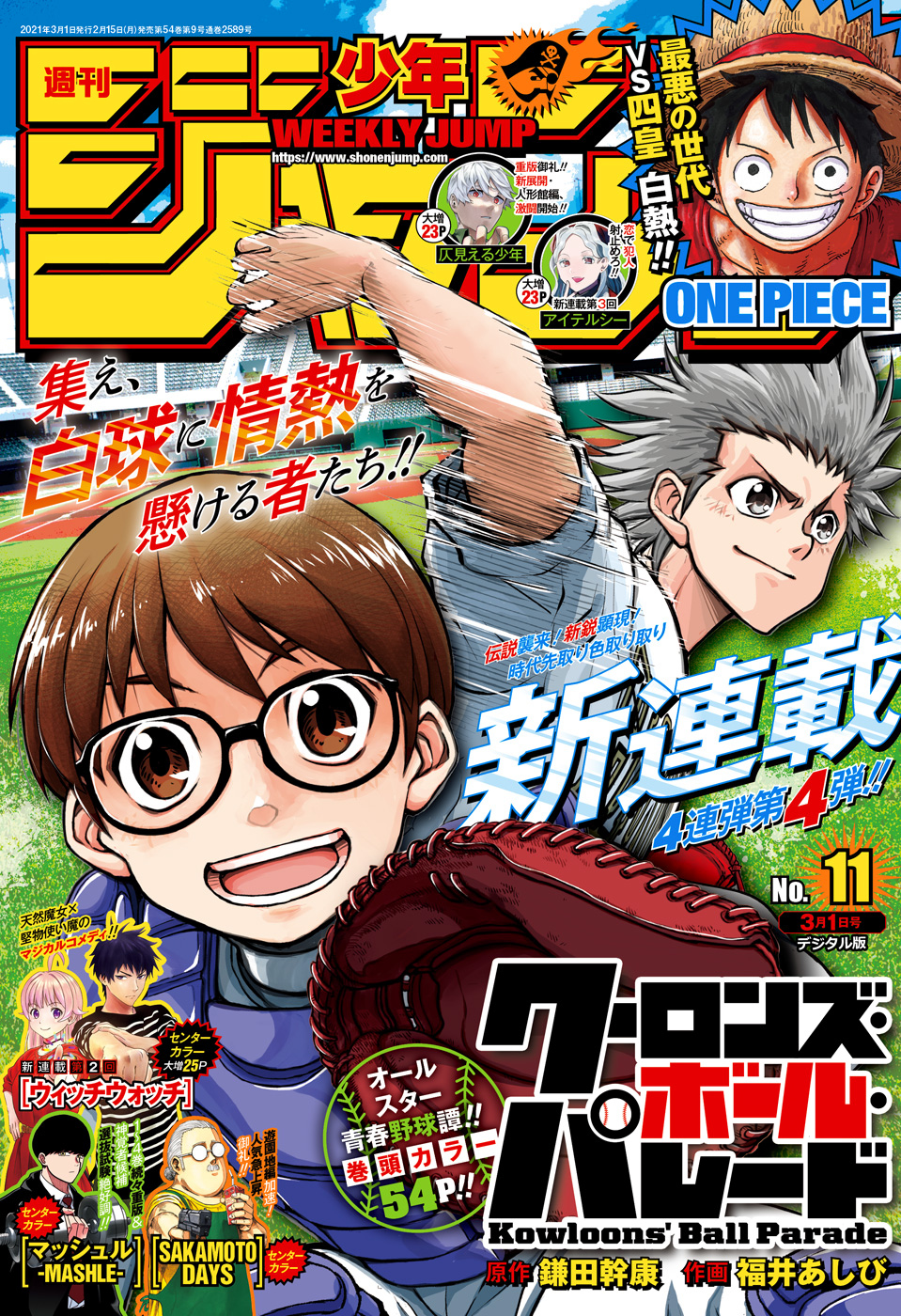
It's pretty normal for Jump to have at least one sports manga running at any given time. The basketball manga Slam Dunk ran during the 90s, and subsequently appeared in the US localization of Jump in the 2000s. More recently, volleyball manga Haikyu enjoyed a long and successful run thru the 2010s, and a similarly succesful anime adaptation.
Haikyu was one of many series to end last year; 2020 saw an unusually large amount of turnover for Jump, making the number of current Jump series under 100 chapters unusually high. Here, about a year later, is a replacement: Nine Dragons' Ball Parade, a new baseball manga.
NDBP is Jump's most recent addition, the last of four new series that debuted at the beginning of 2021. It follows the adventures of a young catcher and pitcher as they follow their dreams to slowly build their own baseball team. The series has only been out a couple of months, and I kind of keep forgetting just how good it is from week to week.
The plot structure necessitates a very slow introduction of characters, so there's plenty of time to get to know each one as the series progresses. It reminds me a bit of One Piece's slow and methodical approach to building its main cast in Luffy's pirate crew. We've only got four main cast members so far, but I'm excited to see where the series goes with them, especially once they start getting into actual baseball games.
WITCH WATCH
8 CHAPTERS
DEBUTED FEBRUARY 2021
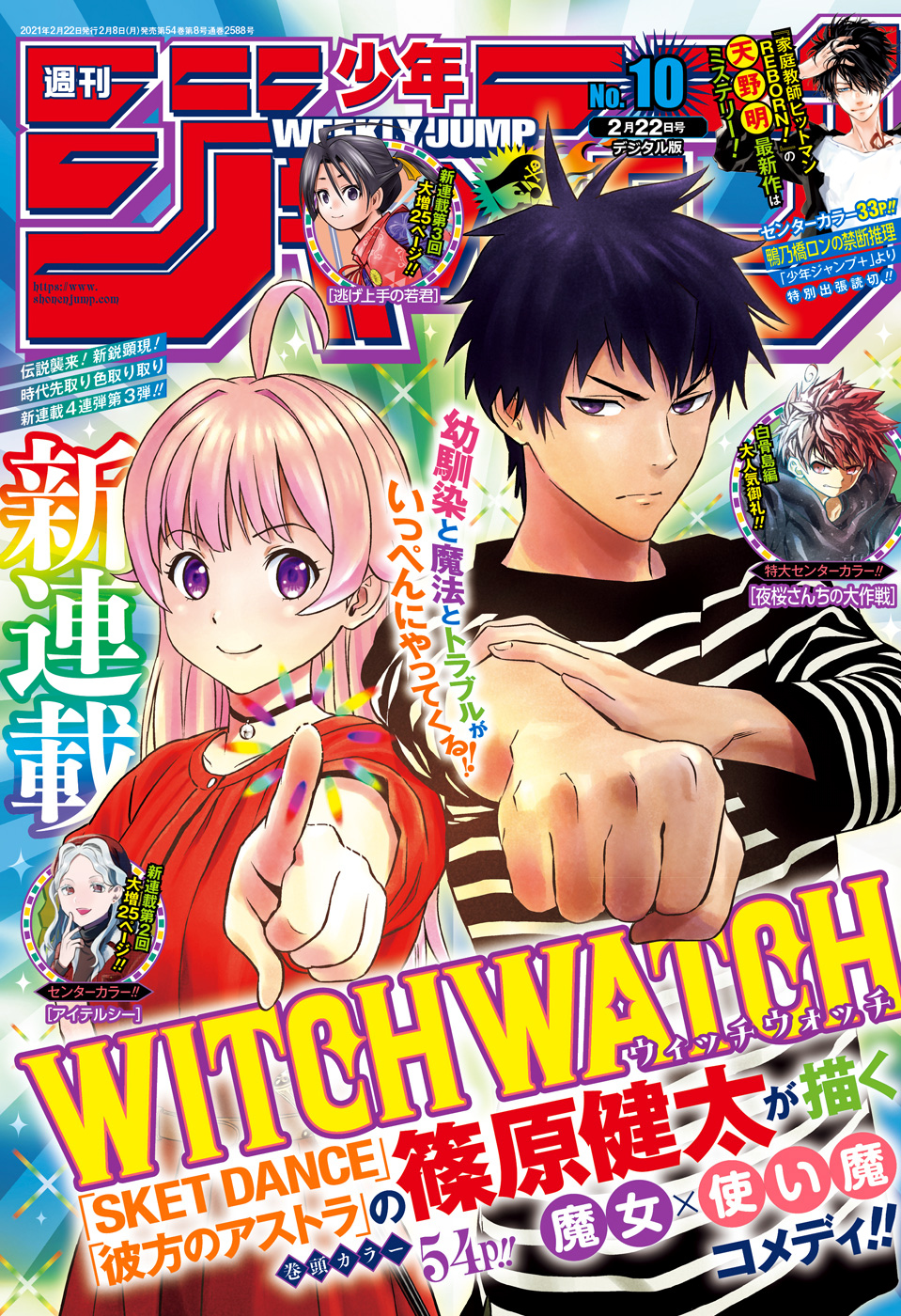
Jump series are mostly categorized into two broad categories: series centered heavily around a serialized plot, with each chapter adding to a greater whole; and series that are mostly one-off stories, often focused on comedy, called "gag manga." For instance, Witch Watch is straight-up a fantasy slice-of-life gag manga, and it's fantastic.
Witch Watch, by veteran mangaka Kenta Shinohara, follows a young witch named Nico and her ogre childhood best friend, Mori. When Mori learns that doom may soon befall the witch, he agrees to protect her as her personal bodyguard.
With stories about young witches, I generally expect the witch to be underpowered as she learns how to use her magic, such as in Kiki's Delivery Service or Little Witch Academia. In Witch Watch, Nico has no such handicap. She begins the story with extraordinary abilities, and performs a new unusual spell about once per chapter. This leads to some visually impressive sequences.
The story still has drama, though, because Nico has no idea how to interact with people, even though she badly wants to make friends and help as many people as possible. This openhearted and extroverted nature often clashes with Mori's overprotectiveness, which is the heart of the series' drama.
Right now, this is the series that excites me the most from week to week. It's fun, it's creative, and it's expertly drawn. Only two months in, and I'm totally on board with this one.
I TELL C
9 CHAPTERS
DEBUTED FEBRUARY 2021
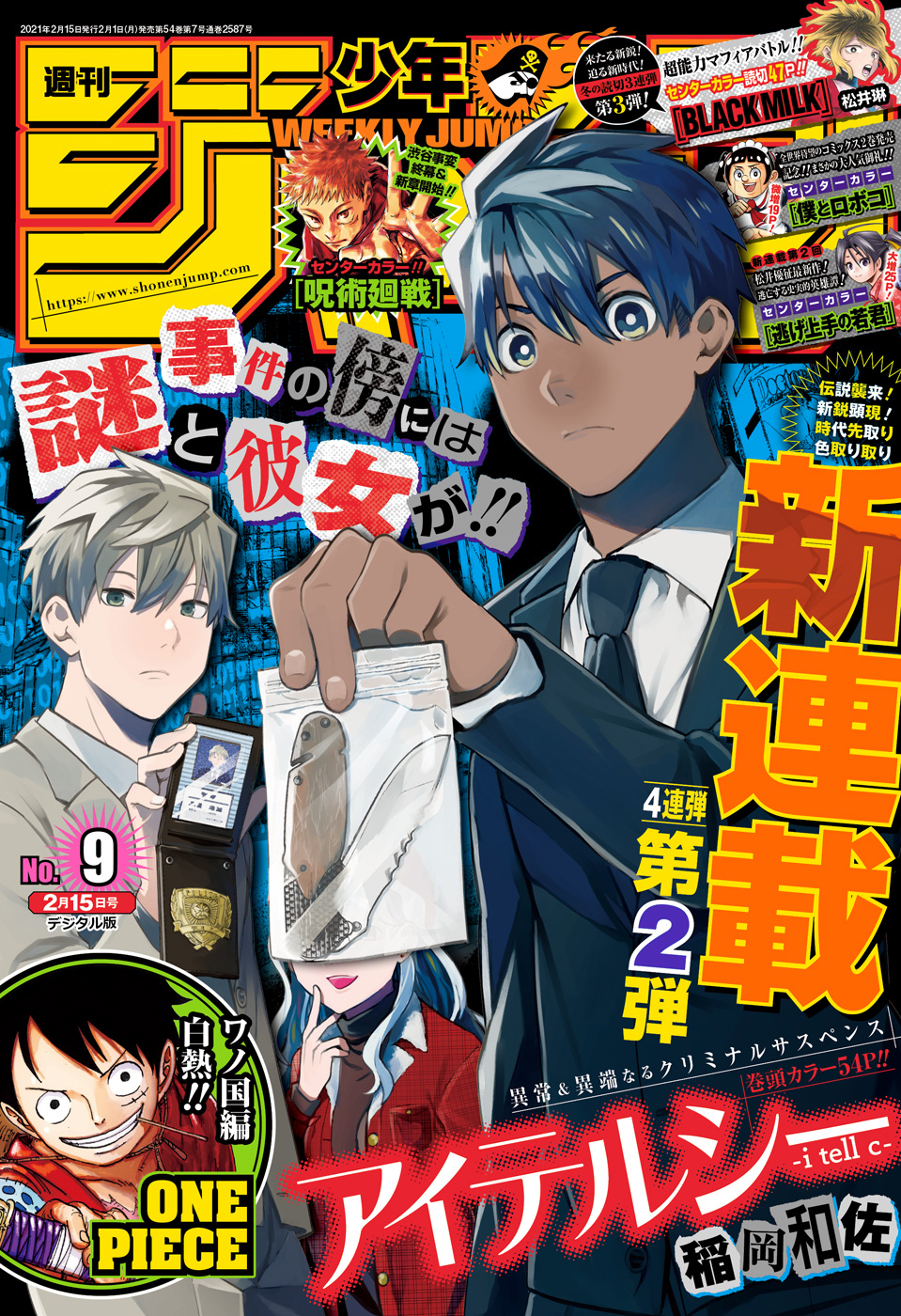
i tell c is a mystery series, written and drawn by Kazusa Inaoka, who has contributed two short series to Jump in the last few years. It stars three detectives who go after serial killers together. Two of them are twin brothers, each with a different approach to solving crime. The third is a young woman who falls in love with the criminal of every case, and uses her considerable deductive powers to determine the criminal's identity so that she can date him. The two twin detectives tend to solve each case by following the young woman as she goes off on her own to find and profess her love to the criminal.
I really can't get a bead on this series yet. After a few chapters that felt relatively formulaic, the series kicked its plot into high gear and had a few chapters of serious consequence to the status quo. Since then, it's seemed to settle back into a new routine. The premise is definitely strange, and I'm not sure it's in a way that I like. But the art is good, and I end up caring about the woman detective more as her backstory is revealed, so... fingers crossed on this one.
THE ELUSIVE SAMURAI
10 CHAPTERS
DEBUTED JANUARY 2021

This was the first new series to debut in 2021, and as a result it's the one that's settled the most into a routine from week to week. But it's still really really solid.
Yusei Matsui, who previously wrote a hugely popular series during the 2010s called Assassination Classroom, here tells the story of Hojo Tokiyuki, a young boy prince who just barely escapes his family's slaughter in the 1333 Siege of Kamakura. He's protected by Suwa Yorishige, a father figure with strange and prophetic visions of the future. Suwa takes Hojo under his wing in order to help train him, and gather an army to take back his homeland.
This is sort of a strange idea for a series on its face, especially if you know how the story ended in real life. (It's not a particularly shonen-friendly happy ending.) Even the manga itself admits in its narration that the characters are barely a footnote in historical texts.
But on a structural level, this is genius. It's the similar sort of training setup, along with slowly getting to know a steadily growing cast of characters, that you expect to see in battle manga like Naruto or Dragon Ball.
And the characters themselves are fun. Suwa gets a bit grating at times; his visions frequently prophesize Shonen Jump itself, which is... a bit much. But the young Hojo is a totally charming character. His whole gimmick is that he's better at running away from things than anybody else, and Suwa decides to lean on that strength in his training. It's an unusual take, in a genre that valorizes courage, to celebrate the act of fleeing as a positive character trait and a valuable tactical strategy.
SAKAMOTO DAYS
17 CHAPTERS
DEBUTED NOVEMBER 2020

Sakamoto Days is a series about an old and mute hitman named Sakamoto, who decides to retire from the assassination business to run a convenience store with his wife and daughter. The plot begins when people from his old life (first allies, and then enemies) begin to trickle back into his new life, and the series' drama revolves not only around whether he'll be able to protect his family, but also whether he'll be able to shield them from the potential psychological damage of being targeted by assassins.
Sakamoto Days is mostly (at first) a comedy manga, especially in its setup. The viewpoint character is Shin, an ally of Sakamoto's who's also a clairvoyant, so he can hear Sakamoto's thoughts and communicate with him telepathically. Sakamoto himself is a tubby dude, but he gets into action scenes with the vigor of a young man.
But it's the best type of comedy manga, because it's one that has serious drama for its characters. The stakes are high, but they're also hilarious; in one sequence, the wife and daughter decide to visit a haunted house at a funfair, and Sakamoto and Shin must protect them from assassins in a way that convinces them that the assassins are just part of the attraction.
As time has gone on, Sakamoto Days has shifted gradually to a more serialized plot, which is actually a shame; there's not much to the plot, but its one-and-done comedy ideas from week to week tend to be a lot of fun. Still, this is a really good series most weeks.
BUILD KING
18 CHAPTERS
DEBUTED NOVEMBER 2020

I don't think I've ever seen something that is so specifically trying to copy One Piece. From the exaggerated art style, to the reckless optimism of its protagonist (who wants to be King, in this case of the builders rather than the pirates), even down to the specific way the protagonist's ranged attack is drawn, this is a series that saw One Piece about to pass its 1000 chapter mark and thought, how hard can it be?
Of course, something as monstrously popular as One Piece is extremely difficult to copy, and Build King definitely fails at it, and generally fails at being an entertaining series at all. But it's certainly a fascinating one. Our heroes are Tonkachi and Renga, two brothers who grew up on a desert island and learned how to build impressive dwellings for its animal inhabitants. Or rather, one of them learned how. Renga is a decent architect, but Tonkachi's enthusiasm often gets the better of him, and he'd much rather have fun smashing things with his hammer.
Both boys want to be master builders in a society that highly values architects that can do impossible things, and so the story follows them in their quest to become great architects. Along the way they encounter living house-beasts, a tournament designed to qualify builders with licenses, and dwellings that seem to be built impossibly.
There's some unique visuals in this series, and I'm particularly intrigued by the overly elaborate drawing style of the characters. It's a look that reminds me a bit of Jojo's Bizarre Adventure, and it's clearly worked out well for the mangaka, who worked previously on a Jump series about a gourmet cook that ran in the magazine for nearly a decade in the 2010s. But this particular story really isn't doing it for me, and it's frequently my least favorite Jump series, except for weeks when Hard-Boiled Cop & Dolphin is having a particularly incompetent week.
PHANTOM SEER
29 CHAPTERS
DEBUTED AUGUST 2020
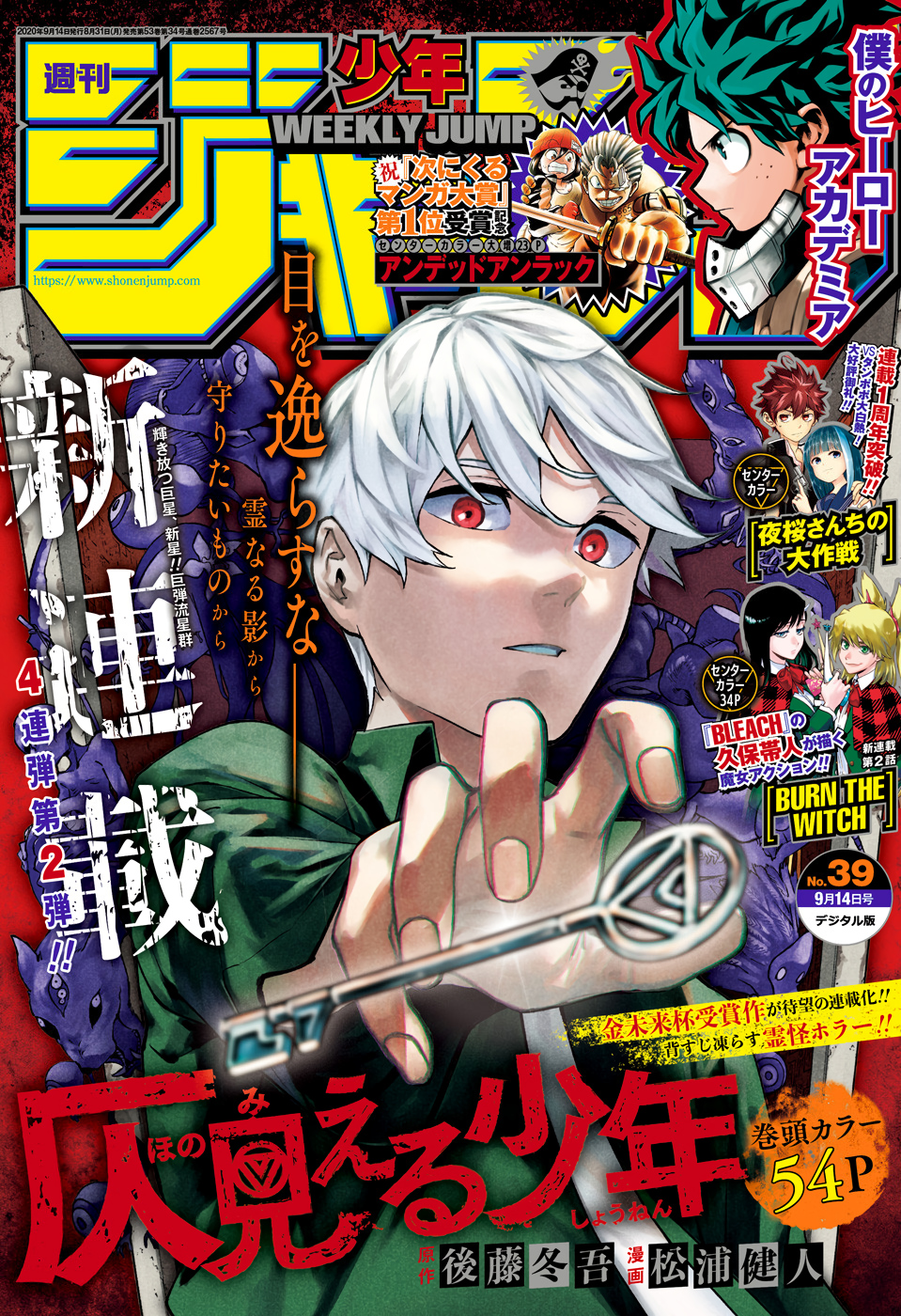
I can forgive a series a lot of flaws if it has some interesting ideas that are well-executed. Phantom Seer doesn't have the most compelling of plots, exactly. Riku is a normal high school girl who meets Iori, a fellow student who exorcises spirits. The problem is, he'd rather just be a normal person. Thru their adventures together, Riku learns about her own supernatural powers as a Beckoning Hand, and Iori slowly learns to care about things again.
"Plucky girl and stubborn dude" is an extremely common duo in anime and manga. You can see it everywhere from Witch Watch in Jump, to the light novel series Haruhi Suzumiya. There's nothing wrong with using a well-established trope, but I think Phantom Seer's biggest flaw is the aimlessness of Iori's desires. If you compare this to Undead Unluck later on, which has a main character whose goal is to die, Iori doesn't really do much work to reach his goal. He just enters every action scene with a resigned tone, like he's saying "mom, do I HAVE to?"
But Phantom Seer is selling very well, and I'm not surprised. On a micro level, I think this series works great. There's a fun sequence that takes place within a mirror funhouse. There's a story arc where an old friend of Iori's shows up, and begins transforming into a half-phantom hybrid. The most recent storyline involves a villain who turns everybody into dolls. The concepts are a great mix of creepy and cool, and the art style emphasizes their grotesqueness beautifully.
Phantom Seer is created by a team of two: Togo Goto, who's writing his first Jump manga here, and Kento Matsuura, who previously illustrated Tokyo Shinobi Squad in Jump in 2019. At time of writing, Jump has announced the impending cancellation of Phantom Seer. I was disappointed at first, but I think Jump may have seen the fact that this series doesn't really work at its core on a long-term basis. I do hope to see these two working on another project in the future, because this has been a delight to read from week to week.
HIGH SCHOOL FAMILY
32 CHAPTERS
DEBUTED SEPTEMBER 2020

Jump debuted a huge number of comedy manga last year. Some of them have since been cancelled, but many haven't. It felt overwhelming in 2020; now, the balance is a bit better.
I'll be honest, I don't really read Jump for the comedy series, so I didn't really care for most of the new comedy series that debuted last year, with a few exceptions. But all the ones that have stuck around have grown on me a little, including High School Family.
High School Family has a really simple premise: a boy goes to high school for the first time, and to his dismay, he's joined by his little sister, and their mother and father, and their cat. That's the sort of goofy premise where the jokes basically write themselves; the younger sister becomes the class' precocious genius, the mother bakes for everybody, the cat becomes the class mascot, and so on.
The boy, who's the only character who's the correct age (and species) for high school, is pretty understandably put off by all of this. But the more the series has gradually shifted focus away from him, the better it's gotten. Because at its heart, High School Family is a fish out of water story about a group of people in a situation they're not really prepared for. The more the story focuses on their struggles and their earnest attempts to fit in, the more the story's heart shines through.
The best character is easily the father. We get the most information on his backstory: he was part of a successful business and was all set up for a promotion, but decided to leave his job in order to fulfill his dream of attending high school. He gets the most characters from his past filtering back into the story, and he gets the most compelling arcs, such as when he tries out for the volleyball team but ends up becoming the team's errand boy.
It's not an amazing series, but as a comedy filler between the magazine's bigger series, it now fits perfectly, because it's not just cringe comedy anymore. It's an earnest story with heart and love, even if it's a weird one.
ME & ROBOCO
35 CHAPTERS
DEBUTED JULY 2020
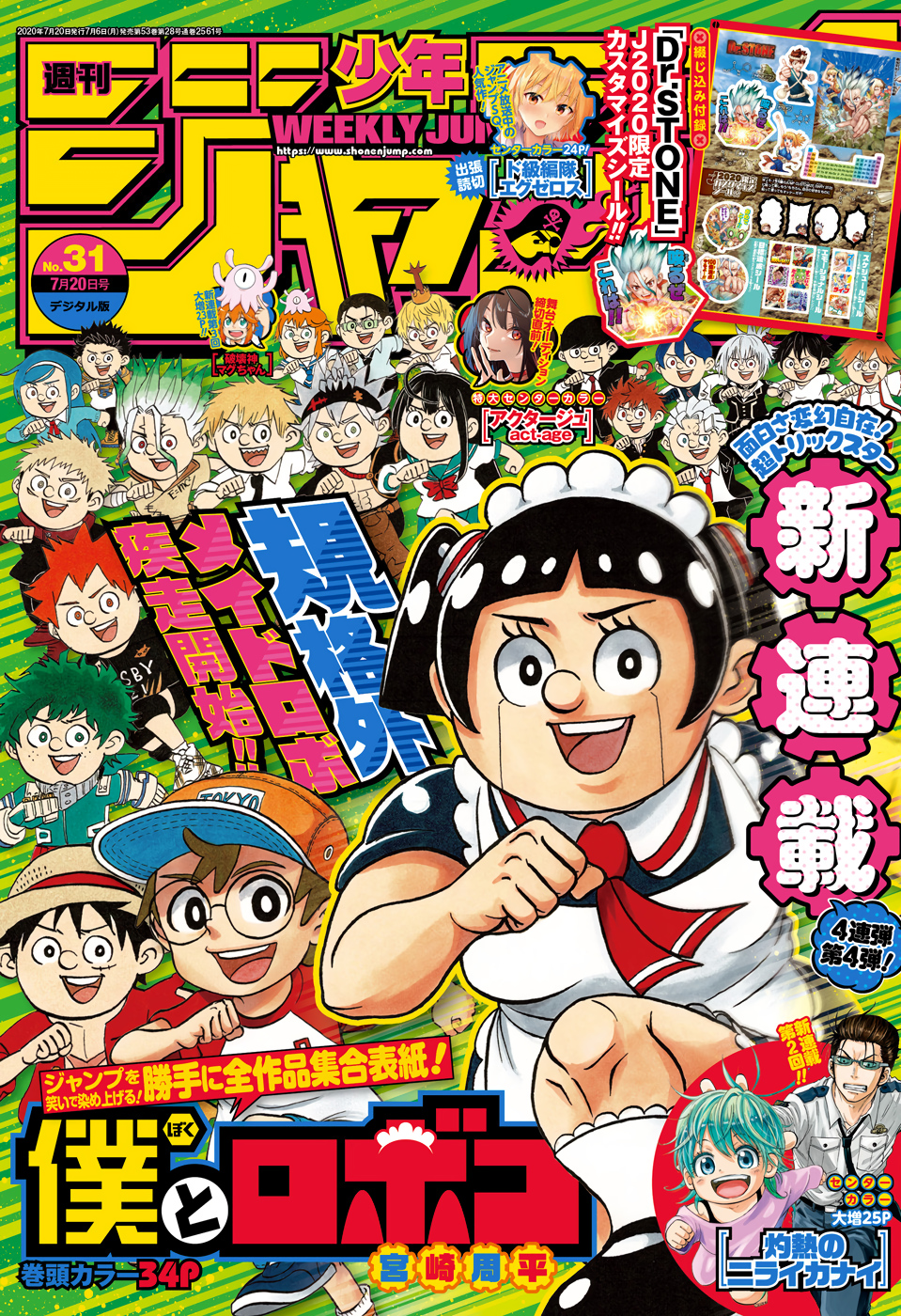
Me & Roboco is a comedy series about reading Shonen Jump. That seems obvious from its debut cover art, but it took me a while to figure out, and honestly I think it also took a while to crystalize in the plot. Going back to the earliest chapters, it took nearly a dozen chapters for Jump itself to start featuring heavily into the fabric of Me & Roboco.
Me & Roboco takes place an unknown period of time into the future in which everybody has their own robot maid. When kid protagonist Bondo's family finally gets one, the maid (named Roboco) is strangely different from everybody else's. She's differently shaped from other robot maids, and she seems to have no conception of how to do basic maid duties, like cooking a meal or cleaning a room.
Early on, the drama of each heavily gag-focused manga is about what you'd expect from that premise: where did Roboco come from, will she learn how to be a good maid, and will she and Bondo get along? There's a pretty solid supporting cast, including my favorite characters: a couple of bullies in Bondo's class who always turn their bullying around at the last moment into something super supportive. It's a really good joke every time.
As time goes on, we learn something really important about Bondo and his friendgroup: they're all huge fans of Shonen Jump. A lot of the jokes and plots in later chapters revolve around homages to classic and current Jump series. But the best chapters are about how Jump brings the friendgroup together in little ways, how the lessons of friendship inherent in most Jump series resonate out into the real world. For that reason, this is probably the most solid series Jump has that's purely comedy and has zero aspirations to be a serialized narrative. It fits the magazine perfectly.
HARD-BOILED COP & DOLPHIN
36 CHAPTERS
DEBUTED JUNE 2020
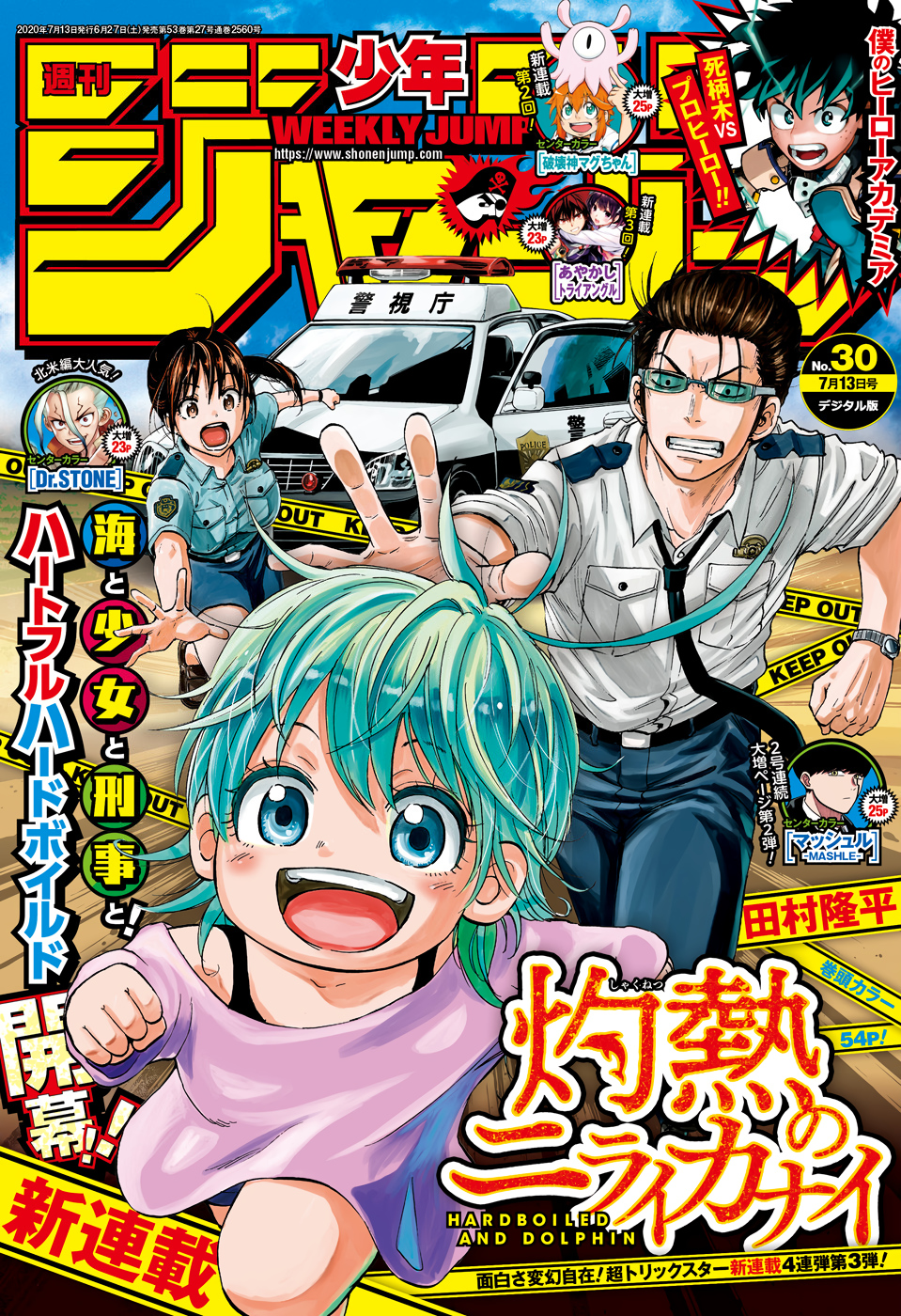
I already played my hand here earlier, but oh well: this series is a mess. Build King may be a ripoff, but I think this is my least favorite currently running Jump series both in conception and execution.
HBC&D is about a cop named Boyle (cause he's hard-"Boyle"d, get it?) who's shipped off to a small island town as a punishment. His new partner is an anthropomorphic dolphin man named Orpheus, and Orpheus' young adoptive daughter Chako. Together, the three of them investigate crimes on the island, mostly perpetrated by other anthropomorphized sea creature immigrants from the surrounding waters (ugh), as well as a cult that lionizes the young Chako as their prophet, and keeps trying to kidnap her (also ugh).
Like, I dunno, I feel like just describing this manga's plot should be enough to explain why it's bad. It plays into the sorts of stereotypes that empower cops to commit horrible acts against citizens: all the criminals here are illegal immigrants and child-stealers.
At least with i tell c, another cop drama in Jump, the characters are less cop than they are detective, and there's a lot more empathy given to the criminals, and more shades of gray about the motives and methods of the police. Here, the conflicts are all very one-sided.
And it's not even GOOD copaganda! At least the most recent arc has devolved into a race for an ancient temple, like the series has turned into Indiana Jones. Most of the time, the writing is very boring and pedantic, there's way too much exposition, the characters are extremely unlikeable, and the art does not work. All of the character design is very lanky and one-note, and there's no real sense of action. This series can't get cancelled quickly enough.
MAGU-CHAN: GOD OF DESTRUCTION
37 CHAPTERS
DEBUTED JUNE 2020
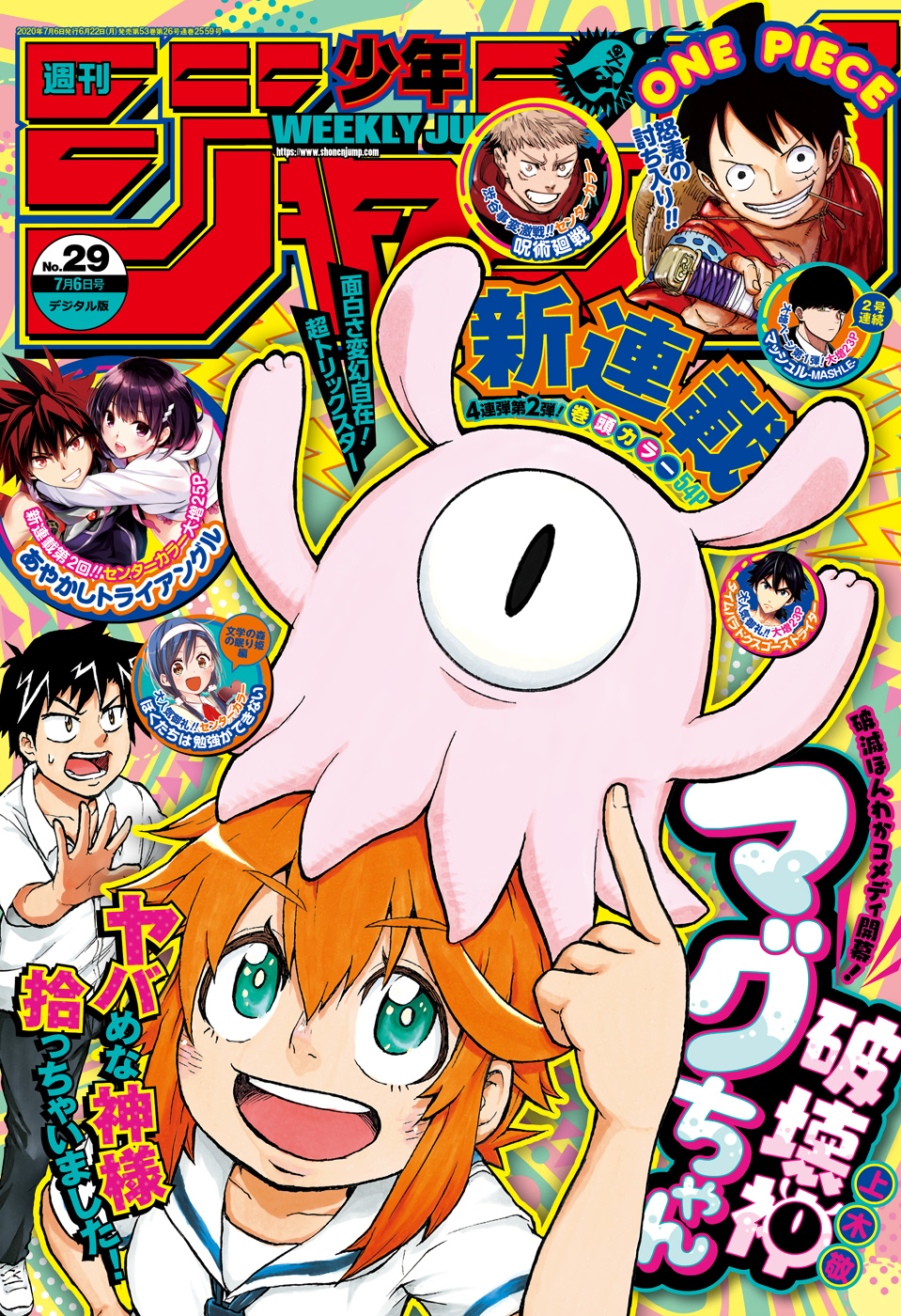
Magu-chan was the first in a slew of comedy manga that came out last summer. At the time, I didn't really care for Magu-chan, because its premise seems shallow at first. But this is a surprisingly deep series that I've come to love dearly.
The plot of Magu-chan: God of Destruction kicks off when a young girl named Ruru, while digging for clams on the beach, finds a gem and accidentally unleashes an ancient spirit named Magu Menueku. Magu enjoyed a period of time on Earth as an all-powerful god of destruction, but there's a problem. With so much time sealed away, and his old cult dissolved, Magu arrives back on Earth as a tiny and underpowered octopus-like creature who nobody seems to remember.
The good news for him - and Ruru - is that Ruru lives alone, and is happy to have a new friend. The two begin living together and bond over their shared experiences. Slowly over time, the cast grows larger, with both new human characters and new supernatural gods and spirits.
"A human teaches a nonhuman creature how to exist in the real world" is a fairly common trope; hell, it was even used in the first live-action Thor movie. What makes Magu-chan work so well for me is how much these two need each other. Ruru lives alone and needs a lot more support and friendship than she has, and Magu-chan needs followers to have any power. But since nobody in Ruru's friendgroup is willing to be a cult member, what that translates to here is that he needs friends.
Ruru's the heart of the series, especially as her friendgroup meets more and more nonhuman gods and spirits. She's extremely kindhearted and frequently forgets to think of herself, and part of her character arc is about learning how to be a little bit selfish and get more support. I found that extremely sweet and relatable.
There's one more bit of uniqueness that Magu-chan has going for it, and I suspect it's the main reason (along with the sweet heart at the series core) that the series has lasted so long. More than any other currently running series, Magu-chan celebrates the changing of the seasons. It's had chapters coinciding with Halloween, Valentine's Day, Christmas, spring break, and more. That's kind of an important staple for Jump, and no other series right now is really doing that.
AYAKASHI TRIANGLE
38 CHAPTERS
DEBUTED JUNE 2020
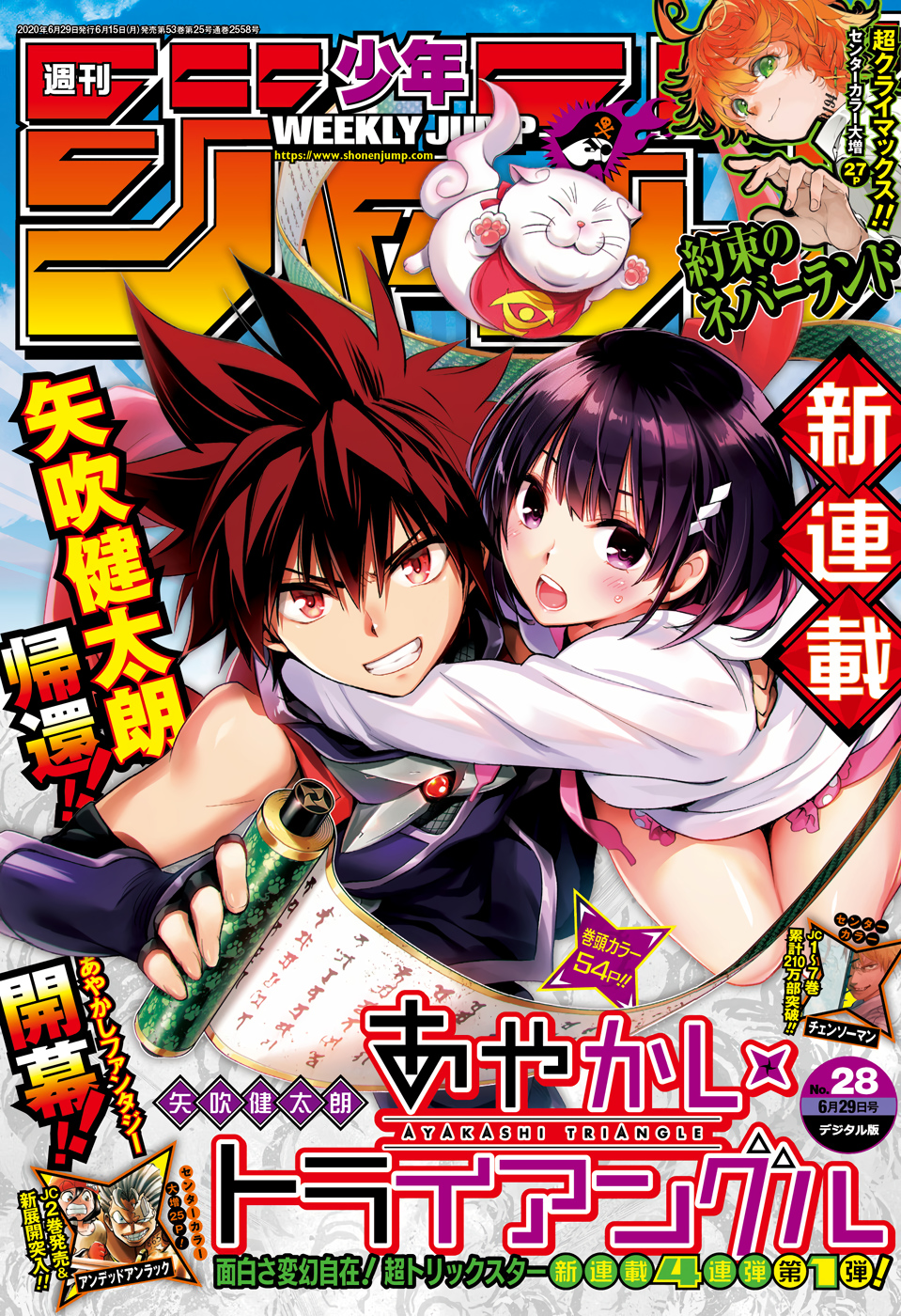
Ayakashi Triangle is a genderbend manga. You should have a sense of whether you'd like this series from that short description, because that's pretty much the only card this series has to play. But it's a pretty good card.
In the first chapter, childhood friends Matsuri (an exorcist ninja) and Suzu (a spirit medium) go up against Shirogane, the King of Ayakashi. As they're about to defeat him, Shirogane laments that his defeat could cause the two childhood friends to become closer, and maybe even hook up. He casts a spell on Matsuri to change his gender, hoping that the two best friends both being girls will stop them from beginning a romantic relationship.
Incredibly, he's successful. Both Matsuri and Suzu feel weird about the idea of dating each other while they're both girls, but they also clearly have an affection for each other. So Matsuri works hard to get turned back into a boy, while Suzu learns about her own powers as a spiritual medium.
So yeah, there's really no getting around this: Ayakashi Triangle is horny. Easily the horniest series of the bunch, which Jump noticed, because it's the only series that you can't read thru the app; you have to read it thru a browser on a computer. It's actually a replacement for Jump's previous ecchi series (a term used for content that's sexually charged), Yuuna & the Haunted Hot Springs, which ended right before this debuted last summer.
There's nothing wrong with a horny series; Ayakashi Triangle never has explicit content, and it still fits within the general tone of Jump. And as a transgender person, I'm a sucker for genderbend manga; I've read plenty of Ranma 1/2. But you'd kinda hope that a genderbend manga would have a little more to it than that, and Ayakashi Triangle really doesn't.
It does try. Just like Ranma 1/2, Ayakashi Triangle frequently adds new characters who could distract one or both of the leads from their relationship with each other, hence the title "Ayakashi Triangle." But whereas Ranma had a believable web of characters and relationships, Matsuri and Suzu are too close with each other for distractions to be believable.
In addition, there's not much experimentation with the idea of Matsuri and Suzu loving each other as girls. And over time, Matsuri loses interest in turning back into a boy, and the plot's focus shifts to Suzu's powers and her role within the ayakashi world. The friends' relationship, which is the core of the series, kinda gets put on hold.
There's still some good magic and ayakashi action here, and the series is beautifully drawn by Kentaro Yabuki, who's done work on older long-running series Black Cat and To Love Ru. But Ayakashi Triangle definitely underwhelms me more often than I'd like.
MASHLE: MAGIC & MUSCLES
56 CHAPTERS
DEBUTED JANUARY 2020
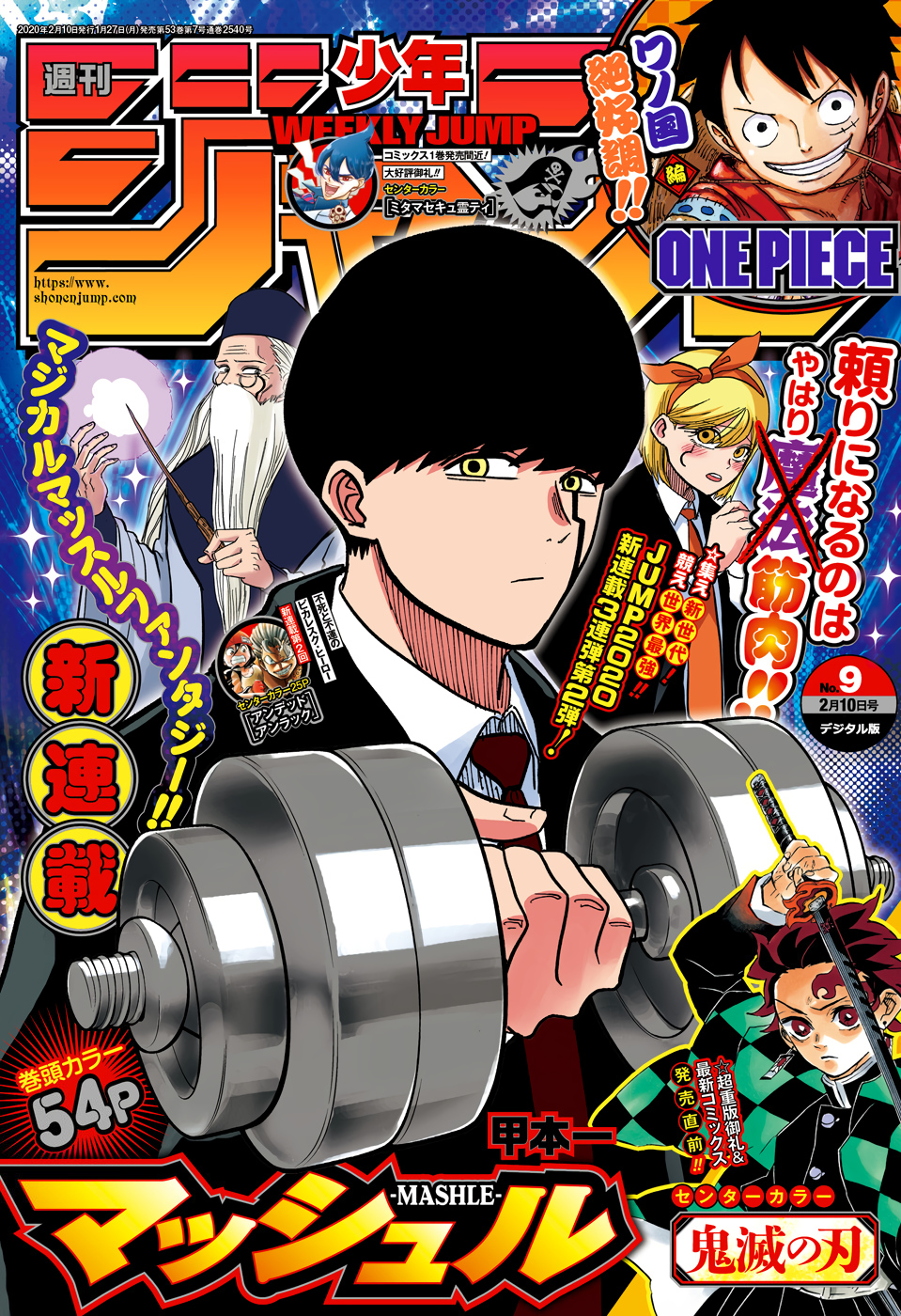
This one took me a couple tries to really get into, but now I definitely understand why this one is so popular. It's a pretty excellent series.
So here's the deal: Jump lost A LOT of its most popular long-running series last year, including Haikyu, The Promised Neverland, and Kimetsu no Yaiba. Jump's been keeping an eye out for up-and-comers that could potentially go the distance, and as a result, both Mashle and Undead Unluck (below) have received a pretty substantial marketing push. It seems to have worked; sales for the two series are good so far, which is helped by the series themselves being very very well done.
Mashle, like the anime Little Witch Academia before it, is a magical school series that seems to be a direct response to Harry Potter. This is most prominently reflected in the protagonist Mash's (fake) scar-shaped facial marking, and in the chapter titles and collection covers that echo elements of the Harry Potter series.
The premise is this: in a dystopian fantasy world, anybody without magical powers is killed by the government. The unmagical Mash Burnedead lives in the forest with his father, who has trained Mash so much that Mash now has incredible physical strength. When the government finds out about Mash and his father's magicless existence, they threaten to kill them both. Mash impresses them so much with his physical strength that the government official gives him an impossible task: go to magical school and become a Divine Visionary, and they'll allow him to live.
Class struggle is really the heart and soul of Mashle. Within the halls of the magical school (which is already a place in which the lowest class, nonmagical people, are banned from existence), the characters with the most social status and magical power are invariably rich upperclass snobs and assholes. Mash is an unstoppable force that pretty much nobody is ready to confront. Some befriend him, and others fight him, but pretty much nobody is able to really break him.
It's extremely cathartic, especially with how poorly Harry Potter has aged over time. A lot of the core elements that lead to the class struggle at this series' forefront are identical to Harry Potter: nonmagical people were banned from Hogwarts, and the main character of that series inherited a large fortune and was the child of two powerful and popular magic users. Only this time, characters like Harry Potter are usually the antagonists. The only main trait Mash shares with Harry is his close circle of friends.
I haven't seen this sort of direct response to Harry Potter stateside, but this is the second time I've seen a major mainstream Japanese series that's a direct response to and critique of Harry Potter. Just a few years ago, Little Witch Academia portrayed a magical school in which its bureaucracy and students were out of touch with society, its tech was out of date, and the relevance of magic was fading as a result. In that series, it also took a lower-class outsider to start really changing the system for the better. In Harry Potter, Hogwarts was a magical and wondrous place; in Little Witch and Mashle, the magical school is itself a major source of the series' conflict.
No wonder Mashle is popular, especially with how far J.K. Rowling has fallen in recent years. But here's what matters: this doesn't just work in response to Harry Potter, but on its own terms as well. Mashle is very funny, visually stunning, and frequently surprising. It has a fantastic cast of characters. It has the heart and determination that fuels the best of the Jump series. Mashle deserves to run for as long as the mangaka wants to write and draw it, and given the current state of Jump, I'd say it'll be around for a good while.
UNDEAD UNLUCK
57 CHAPTERS
DEBUTED JANUARY 2020
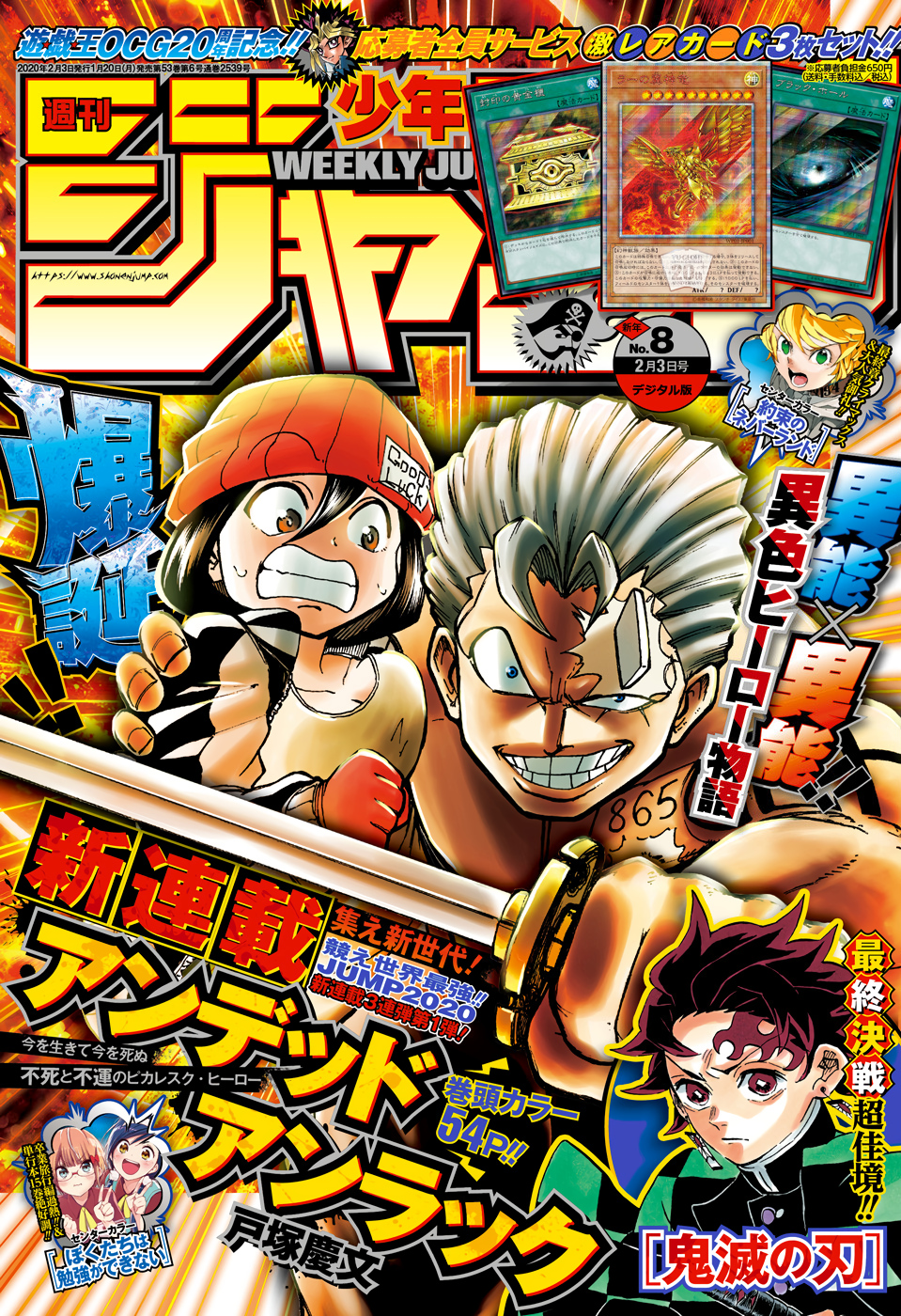
Undead Unluck is a straight-up fantastic series, and it's in close competition for my favorite series currently running in Jump. So far, only one other series (the next entry) is a strong contender.
18-year-old Fuuko Izumo has a strange power: anybody who touches her gets hit with a stroke of bad luck, often bad enough to injure or kill them. Having finished her favorite manga, she decides to kill herself. A strange man sees her about to jump and hears about her bad luck, and touches her in order to receive her bad luck. He immediately gets hit by a train, but it doesn't kill him; turns out he's an undead zombie, and he's looking for a way to get killed for real. The two (Undead and Unluck) embark on a quest to figure out how to help the zombie (who Fuuko names Andy) find a final death.
That's a pretty basic premise that doesn't necessarily seem like it could expand into a full-length series. Mangaka Yoshifumi Tozuka, who's done a few Jump one-shots and writes his first full series here, slowly expands the concept into something epic and heartfelt. This starts when Fuuko and Andy discover that there's other "negators" with strange supernatural abilities starting with the letters "Un-".
And if there's other people with abilties, of course there's groups of people with these abilities, like the Union. And if there's groups of people with these abilities, of course they're embarking on a quest to save the universe from total destruction by embarking on difficult sidequests to capture or kill other negators and embodied rules of the universe. ... Wait, what?
The writing of this series is SO SO GOOD. Nearly every character in its extensive cast is likeable and/or interesting, and the characters have great depth to them. The overarching plot, which deals with the strange way in which this world works, is fascinating to watch unfold.
If I have any qualms about the series, it's that it feels like the main characters don't drive the plot so much, but merely happen to be involved in it. That's not the case for the last entry on this list, in which the characters and the plot inform each other constantly. But it's a small quibble. Undead Unluck is cool, and it's gripping, and it's heartwrenching, and it's sweet, and it's fun. It's a top-tier Jump series.
MISSION: YOZAKURA FAMILY
76 CHAPTERS
DEBUTED AUGUST 2019

I am completely blown away by how much I've turned around on this series. It easily takes the Most Improved Player award, and might be my favorite series currently running.
Taiyo and Mutsumi are childhood friends. Taiyo lost his family in a car accident somewhat recently, and Mutsumi has a large family of super-spies of all ages. When her overprotective brother Kyoichiro threatens to kill Taiyo for getting too close to Mutsumi, the other members of Mutsumi's family suggest an unusual plan: if Taiyo marries Mutsumi and becomes a family member, Kyoichiro will be unable to kill Taiyo because of the family rules that forbid killing other family members. Ultimately, Taiyo decides to marry Mutsumi after all, regaining the family that he lost in the car accident.
What follows is a spy manga that's structured like a gag manga. Nearly every chapter in the first 20-30 are self-contained stories with strong comedy elements, as Taiyo learns how to become a super-spy so he can protect his wife, and so he can hold his own in missions with his family members. However, because of the plot-heavy nature of the missions, each chapter has a lot more exposition than the average gag manga, so it takes a good deal of time to read.
Now, Yozakura Family is not the only Jump series to deal with a family of spies. Spy x Family, another currently running series that's exclusive to the Jump+ app, has been significantly more popular and better-selling than Yozakura Family. So I was curious as to why Mission: Yozakura Family has been allowed to run for over a year and counting.
Well, around the 30 chapter mark, this series really clicked for me. Things started coming together. Whereas the first bunch of chapters focuses on individual elements (a supporting character here, a subplot there), as the series gets closer to 40 chapters those elements start finally building to create a greater whole. The greater plot starts to get unveiled. The characters, which have now each been established and developed in earlier chapters spotlighting them, get to all work together.
And Mission: Yozakura Family reveals itself as having some of the deepest and richest emotion of any Jump series I've read so far. It's about being part of a family of weirdos, and loving and accepting all of them even with their strange traits. (Except for the ones that are actively harmful.) It's about the long-term effects of grief and trauma, and finding comfort and salvation in the love of the people around you. It's about two people, Taiyo and Mutsumi, in a beautiful mutually supportive relationship, and how they care for each other even when they don't know how.
Mission: Yozakura Family is cool and fun as hell, especially with all the weird superpowers and crazy situations the characters find themselves in on a regular basis. But what really tips it over the edge is an attention to character and a depth of emotion that's really unlike just about any manga series I've ever read. Mission: Yozakura Family is the real deal, and more people should read it.